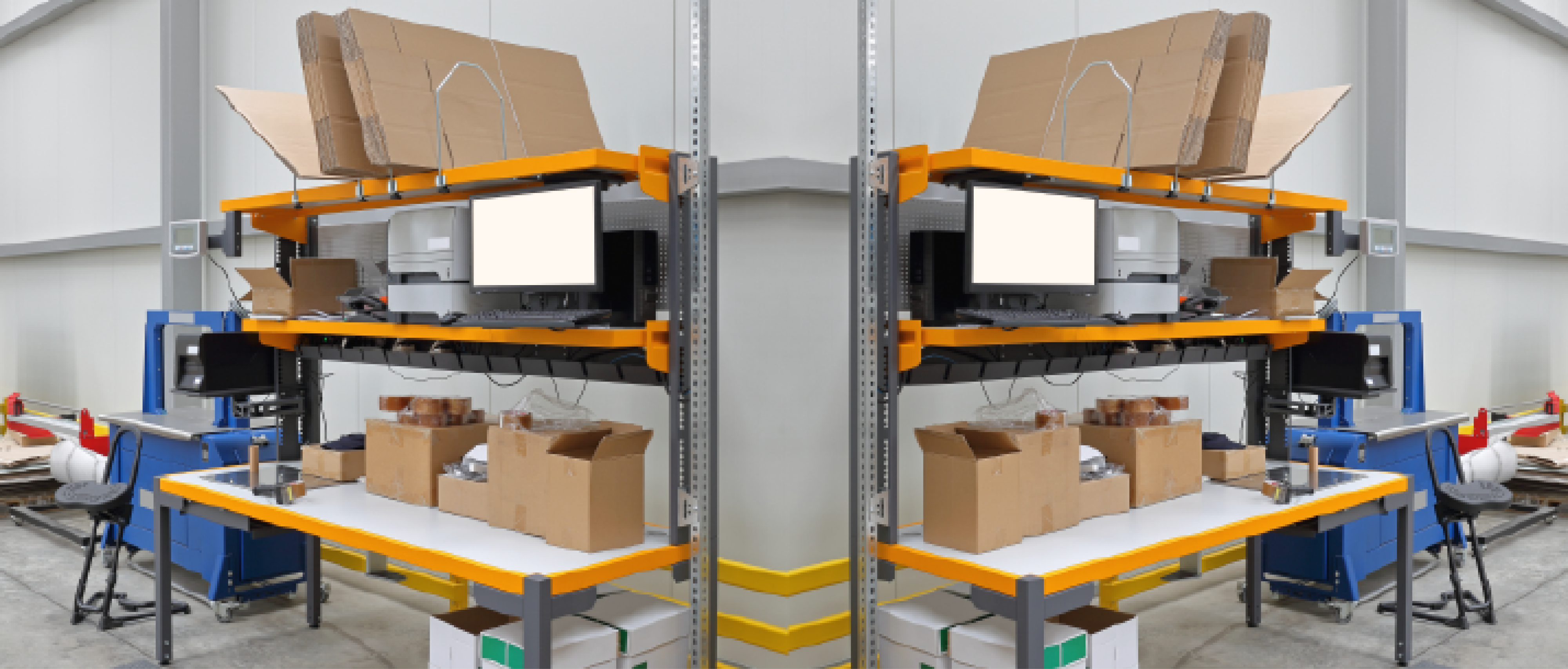Back
Technical
Implementing 5S for seamless warehouse operations
A step‑by‑step look at using 5S to slash clutter and speed flow.

Mewan Wijemanne
Sr. Industrial Engineer, Rabot
Oct 3, 2022
As the logistics and warehouse industry continues to evolve and innovate, there has been a movement towards lean operations.
The fulfillment industry which includes e-commerce warehouses and third-party logistics providers (3PLs) — has seen a significant amount of growth thanks to online shopping and e-commerce. One of the best known ways to optimize for efficiency and cost is the 5S methodology.
The history Of 5S
The 5S approach to workplace organization was first developed in the Japanese automobile industry to make manufacturing more lean and efficient. It remains one of the most effective ways to create a quality work environment, by organizing it in such a way that enables employees to do their best work.
The 5 S’s stand for the Japanese words representing the five practices which optimize the workplace for the workers’ ease of access, safety and performance. The S’s are, in order: Seiri, Seiton, Seiso, Seiketsu and Shitsuke.

In English they can be translated as the following:
Seiri → Sort: The first step is identifying which tools, materials and moving parts are immediately necessary for each station, and separating or removing whatever is not.
Seiton → Set in order: “A place for everything, and everything in its place”. Categorizing and arranging the tools and parts in a neat, ergonomic way so everything is easy to find and use. It can also extend to organizing the workspace itself e.g. floor markers, signs and labels on a warehouse floor.
Seiso → Shine: Conducting regular cleaning and tidying of the work areas and surfaces, doing maintenance of tools and putting them back in the designated places.
Seiketsu → Standardize: Coming up with ways to formalize the first 3 steps, ensuring they are done regularly and up to code. Having concise, measurable criteria which is clearly communicated to the employees helps them to meet the standard, as well as train new workers more easily.
Shitsuke → Sustain: Ensuring that long term, the first 4 S’s become baked into the workplace, through regular audits or quality inspections. At management level, constantly striving for improvement and enabling workers to self-sustain these practices.
Who can benefit from implementing 5S?
Though it got its start in manufacturing, the 5S methodology has been successfully applied to many different types of workplaces. To understand why, let’s list some of the known benefits:
It makes problems easy to identify and address
Easier access to equipment and work stations
Improved safety and hygiene of the workplace
Reduced costs and waste
Increased efficiency and cohesion between departments
Greater employee satisfaction and productivity
Improves overall perception of the company for customers and business partners
How would this apply to warehouses, superstores and retail? Let’s use the warehouse as an example.
In a warehouse, things must move quickly and seamlessly. With deadlines and fulfillment quotas to be met, workers in each station should be able to easily coordinate with each other along every step of the supply chain.
Now, imagine a warehouse where the first 3 S’s are not consistently practiced. Workstations cluttered with unnecessary items would add extra steps to the employee’s workflow, causing frustration and overwhelm when the items they need are not within reach and incoming orders keep piling on.
No labeled storage system would make it harder for employees to quickly and easily find items. It would also be more difficult for them to do inventory and notice missing or damaged items, since they are not in plain sight.
Lastly, without regular cleaning, organizing and maintenance of tools, there is greater potential for accidents and safety hazards. Working in a warehouse often entails lifting large boxes and operating heavy machinery; spills, leaks, rust and mold all become harder to identify and deal with in a timely manner, which can have serious consequences for workers’ safety and rack up costs.
Building a strong foundation for 5S
The first 3 S’s are essentially efforts to minimize all disruptions and bottlenecks which slow down or impede the flow between one department or station to the next. When these have been done reasonably well, all that’s left is Standardizing and Sustaining this system. Many businesses tend to overlook or underestimate the importance of the 4th and 5th steps.
In order to Standardize, targets and expectations need to be reasonable, quantifiable and clearly communicated to the workers. The creation and use of checklists, templates and manuals is part of standardization. In a lean system, employees should be able to easily refer to a manual or chart and continue working without much confusion. If they have to spend too much time thinking and problem-solving, it can be a sign that this step has not been executed well.
Lastly, Sustaining this system requires two things. The first is quality checks and inspections. Some businesses do this in the beginning and, when things seem to be going well, they stop or do this less frequently. Regular, proactive inspections can spot problems in real time, or even catch them before they start. The second is greater involvement of the employees at every level. When their concerns are heard and needs met, employees are more likely to self-sustain a good system which is working for them.
Retail in particular stands to benefit from implementing these principles. Take the example of curbside pickup programs by big-box retailers such as Target and Walmart. In the past two years, curbside pickup has become a popular and necessary service due to social distancing measures taken at the beginning of the pandemic. They have great potential to boost sales and improve customer satisfaction because of the convenience they offer, with many customers reporting they would like these programs to continue even as social distancing relaxes.
While digital tools such as order management software are adopted quickly, many retailers have ways to go when it comes to organizing their store especially for this service. As it was unfamiliar to many retailers, curbside pickup was often hastily tacked onto their usual operations. This sometimes resulted in order volumes higher than retail employees could manage, inventory on websites or apps not updating in real time, and delays in getting orders ready. Regularly updated and visible inventory, dedicated picking teams with ergonomic stations, and quicker communication with the customers are all areas which stand to be improved. This not only affects customer satisfaction but also employee fatigue and burnout.
Implementing 5S in your warehouse
Now that we know the importance of this methodology, how do we set to work on implementing it?
Let’s visualize a warehouse to demonstrate what each step of the process could look like:
Sort
Questions to ask:
What are the items we absolutely need here?
What isn’t useful for this immediate task?
Recommendations:
Keep a checklist of all commonly needed items such as scanners, boxes, tape dispenser, label printer and monitor.
Utilize the “red tagging” system, where unrecognized tools are tagged with a red label and placed in a designated area where other workers can check for the misplaced items.

In this photo, we can see that boxes are sorted by size and placed in their designated slots. This makes it easier for employees to gather needed materials before they start packing their orders and keeps the operation running smoothly.
Set in order
Questions to ask:
What is the best layout for this station to perform the necessary tasks?
Does the associate have any special needs and requirements?
How can things be arranged and space utilized to improve their workflow and speed?
Recommendations:
Boxes and mailers are sorted according to size and placed at a level which is visible and easy to reach.
Tape, label printer, stamps and other small items are stored neatly in bins or tubs, according to the order in which they are needed.
The station has been customized according to the packer’s personal needs: for example if they have back or knee pain, least-used items are placed in such a way that they do not need to bend often. If they are left-handed, items like the monitor are placed accordingly, or the station is positioned so the conveyor belt is on their dominant side. If they are shorter or taller than average, aluminum stations with adjustable heights are used.

At this workstation, we can see the instructions are placed at the employee’s eyelevel. It serves as a visual reminder for packaging boxes correctly. The boxes needed to start a new order are placed neatly in arm’s reach and the conveyor belt is ready to receive packed boxes.
Shine
Questions to ask:
How easy is it to clean up?
Where does mess tend to accumulate?
How often should it be cleaned?
Is it easy to find the correct places to put items back?
Recommendations:
Designated time for employees to clean and get set up before the shift.
The trash bin is within reach and regularly emptied.
The surfaces of the station are wiped regularly.

This workstation is an excellent example of Shine. All materials are placed within reach and most importantly, the screen is at an eye level for ease of access. This station is set up for ergonomics and allows for the workflow to continue easily.
Standardize
Questions to ask:
Is the employee aware of their responsibilities and goals?
Do they have the means to find answers to FAQs by themselves?
Is the correct way of doing things obvious and intuitive?
Can new hires learn it fairly quickly?
Recommendations:
Checklists, charts or manuals are easily accessible.
Assessments make it clear where and how the employee needs to improve.
There is a consistent routine so employees know what to expect, and the 3 S’s become habit.
Sustain
Questions to ask:
Does management conduct regular checks and address employees’ concerns?
Do employees get adequate time to clean and get organized?
Do employees feel everything is running smoothly?
Are they motivated to self-sustain and take ownership?
What can be changed or improved?
Recommendations:
Thorough documentation of quality checks and inspections, with insights.
Fostering communication and trust between employees and management.
Changing or revising policies which are not working.
Keep team leads and supervisors up-to-date with the latest management techniques and re-train when necessary.
Bringing 5S To Your Facility With Rabot
Thanks to Rabot Pack, you can gain visibility into every aspect of your packing operation. Our Vision AI system allows for clear visibility and oversight into your operations, so you can spot what’s working and what needs to be tweaked. Our tools can help streamline your operations, make training employees a breeze and reduce customer complaints. Contact us today to find out more.



